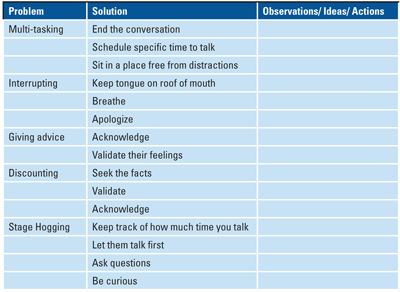Workplace Drama: Listening Mistakes and Solutions
There are many signs that indicate you need help learning to listen. In this article, we talk about the signs, the “drama” that bad listening creates, and the solution if you want to improve your listening skills. The five signs are multitasking, interrupting, giving advice too soon, discounting, and stage hogging.
Multitasking
The problem. When someone is talking while you multitask, you slip in and out of the conversation. The unintentional message you communicate when you multitask is that the other person is not worthy of your attention. In addition, you risk missing important pieces of information. Often it’s in the nuances and inflections where you gain perception about real issues that are uncomfortable to speak about directly.
The solution. When someone wastes your time with chatter, instead of slipping into an activity to make use of your time, it’s more authentic to simply end the conversation than to pretend to listen. This is how to say it: “Janet, I need to tell you that I only have two more minutes to talk. I have a stack of things on my to-do list, and it seems that the time is slipping away.”
Janet will get the hint and you can politely say “good-bye” and get productive again without damaging the relationship.
However, when an employee or colleague really needs your attention, tell the truth about your situation and then schedule a time when you can be fully present.
Interrupting
The problem. Someone’s excitement ignites your own excitement (either negative or positive) and you can’t wait to share your two cents. The reality is, other people don’t care about you when their emotions are in a high state of arousal. They are concerned about finishing what they are saying; therefore what you say won’t register with them anyway. They will think you are rude if you keep interrupting their thought process, and even if you get them to shut up, they won’t be listening to you because they will be frustrated. If you happen to be a “fast processor,” it will be very difficult to stay quiet when someone takes a long time searching for the right word or fumbles around with a lot of Ums, Ahs, and long pauses.
The solution. Put your tongue on the top of your mouth and breathe. If you are sitting at a desk or table (or on the phone), you might want to jot down a thought so you don’t forget what you were going to say. Another solution is to apologize immediately and invite the person to finish the last sentence.
Giving Advice Too Soon
The problem. Have you ever tried to help an employee with a piece of advice only to have it blow up in your face? When someone complains, it’s normal to go straight to a solution. However, most people do not really want advice, especially when they are in the midst of deep emotion. In the beginning, it is never really about the solution—it is about calming down the emotional energy so that a solution can be found.
The solution. Validate and acknowledge. This does not mean that you agree with what is being said. The way you validate and acknowledge is to listen for the emotion and then ask a question that indicates you are trying to understand. For example, if a co-worker is furious and in the midst of drama, instead of saying, “If I were you I would…” You say instead, “It sounds like you are really angry and you are tired of the way things are going….” Then let the person agree or clarify. If they are angry with you, do not defend yourself. Seek to understand before trying to find a solution. You will notice that once people regain their composure, they are then more ready to discuss solutions.
Discounting
The problem. Someone comes to you with a molehill of a problem but acts like it’s a mountain. You are likely to make the molehill grow even bigger if you say, “Oh, don’t worry about it, “or “It’s really not a big deal.”
The solution. Look for facts. You can simply say, “I want to understand more. Can you tell me about …” Then encourage the person to give you the facts instead of just the feelings. Then you can use a validation technique to calm the person even more.
Stage Hogging
The problem. You don’t even know you’re doing it. You talk fast, and you talk a lot. Talking is how you work things out and how you sort out all of your creative ideas. You know the best ways to get things done, and you don’t know why your employees won’t listen. This is the very worst listening mistake, especially if you are a leader, a coach, a consultant, or a sales professional. Others will absolutely feel drained by your hyperactivity and massive energy.
The solution. Pay attention to how much you talk and how much you listen. The old saying is true, “When I talk I know what I know, but when I listen, I know what I know and I know what you know.” Another solution is to always let the other person talk first.
If you start talking first, it’s too easy to get carried away, especially if the other person is an excellent listener. Make sure to draw others in with questions and your own natural curiosity. Avoid the tendency to add one more comment or observation to every thing they say. If it’s your employee, help the employee come up with answers and solutions and you will increase employee engagement.
Use the worksheet below to help you identify and become aware of your own patterns of listening, and see where you can improve.

—Marlene Chism is a regular columnist for MANAGING POWER. She is a professional speaker and the author of Stop Workplace Drama (Wiley 2011).